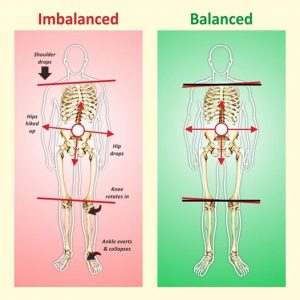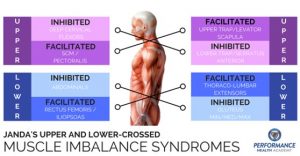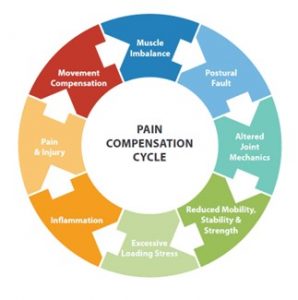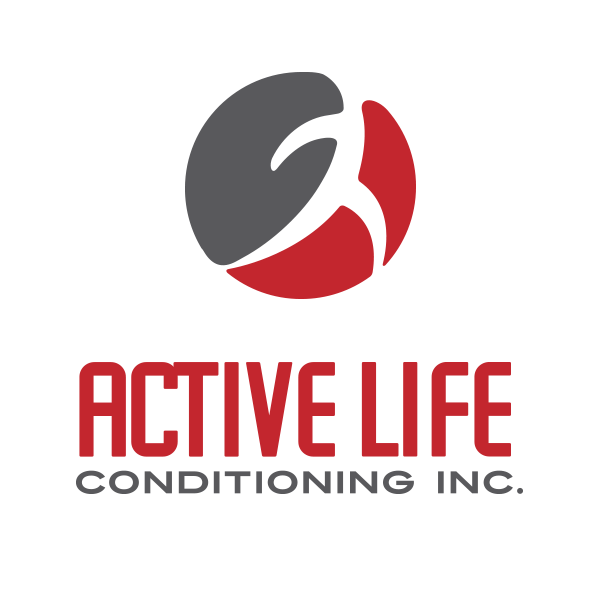Are you out of Balance?
Muscle imbalances

Don’t Let this be you!!!
Muscle imbalances within our body are created by everyday patterns in our lives. Everything from they way you stand (see above), to the activities that you do, sports you play and way you sleep can cause imbalances in your body. Just as we can pick up good habits, we can pick up bad ones. Consider the some of the things that take place in your day (ie. sitting in the car or at a desk for long stretches or standing with more weight on one leg all day dealing with customers) and how it might affect posture or center of gravity. When one or more of our muscles becomes weak, we compensate with other muscles becoming overactive and disrupting the kinetic chain within our body. This disruption places unnecessary stress on your joints, leading areas of the body that are supposed to act as stabilizers to become unstable and areas that are supposed to be mobile to become stiff. Imbalances within the body are followed by compensations leading to more imbalance which causes more potential for injury and pain and a viscous cycle begins. Athletically, we can see these imbalances result in loss of efficiency within our movements causing us to need more energy to execute proper movement and therefore bringing on more fatigue ( ie. a distance runner with poor hip mobility loads their knee more, or a tennis player with poor mid back mobility stress their shoulder more)

This is a picture of the body’s kinetic chain and a representation of what happens if one link in the chain is disrupted. Consider an ankle sprain which goes untreated resulting in a loss of mobility. The collapsing of your ankle can cause rotation at the knee which in turn leads to a drop on one side of the hip and a spinal rotation causing the opposite shoulders to be depressed. As each imbalance travels up or down the kinetic chain our movement becomes less efficient. Imbalances don’t just occur as a result of injury but can also occur from repetitive movement. Repetitive movement, whether sports related, or work related can cause imbalances. Consider sports such as golfing, soccer, or even baseball. The side you swing the club/bat/racquet or leg you kick with often has more mobility and strength from the repetitive motion. If symmetry is not restored through exercising the opposing muscle groups this can lead to imbalances than could cause issues with other activities like running, jumping, cycling etc.

Janda’s upper crossed and lower crossed muscle imbalances illustrate how these overactive and under active muscles in our bodies can impact each other.
Inhibited muscles are usually (but not always) weak and loose, whereas facilitated muscles are often tight and overactive. Sitting down frequently can cause tight hip flexors leading to weak glutes and core this can lead to a variety of problems such a poor gait and low back pain. We often experience tight chest and tight anterior neck muscles from rounding our shoulders and letting our head hang past our shoulders leading to neck pain, reduced mobility in our shoulders and loss of stability in our shoulder blades.
Muscle balance is a viscous cycle. It can start from an injury or from poor posture and movement execution, in the end one muscle imbalance will lead to many more. Most imbalances are not always caught in the early stages and this can lead to joint and tissue damage and pain if not addressed.

To sum it up, all muscles matter! Quality is more important than quantity and consistency is key to seeing improvement. Chances are if you are feeling pain or stiffness or maybe struggling to execute certain movements, you need to work on your imbalances. It is not always easy to recognize your own imbalances. Having a kinesiologist or therapist conduct an assessment to pinpoint those imbalances can help give you areas to address and correct.
Once you know where the imbalances are how do you fix them?
The best place to start is with a coach so they can help you work on developing your proprioception. Proprioception is the connection between your body and your mind to increase your awareness of movement patterns such as the location and direction of your movements and what muscles are doing the work. You can improve proprioception by having someone to help cue you in the early stages, so you can begin to recognize your movements. Things like helping to align your lower body in a lunge or split stance can to activate pelvic stabilizers that are underactive. These stabilizers are necessary to keeping your low back healthy.
It is recommended to take the time to have a movement assessment every couple of years (and yearly for growing children) to ensure that you are staying properly aligned. Don’t hesitate to reach out to book a 30 minute assessment with one of our therapy team.
References:
Link: https://www.performancehealthacademy.com/the-janda-approach-to-chronic-pain-syndromes.html
Book: Assessment and Treatment of Muscle Imbalance: The Janda Approach
Video: https://youtu.be/pNgpQdteF4E


